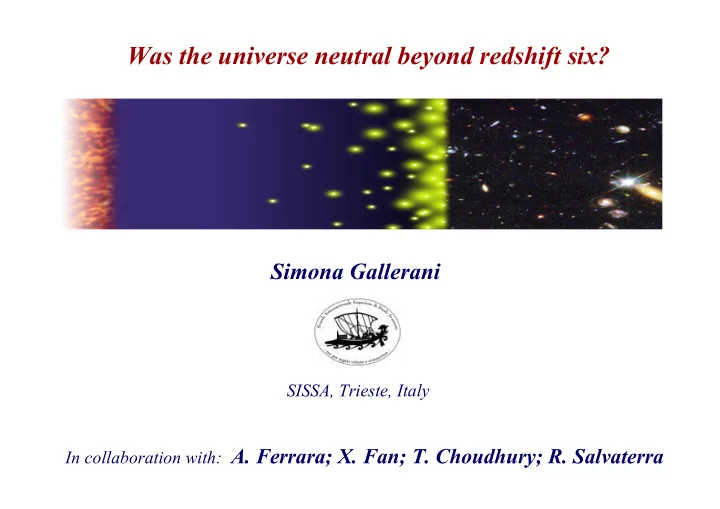

Was the universe neutral beyond redshift six? Simona Gallerani SISSA, Trieste, Italy In collaboration with: A. Ferrara; X. Fan; T. Choudhury; R. Salvaterra
QSO spectra at high redshift GAPS GAPS 1 / 2 � 3 / 2 2 2 h h 1 z � � � � � � � + � 5 ( z ) 4 . 9 10 m b x � � � � � = � � � � � � � GP HI 0 . 13 0 . 02 7 � � � � � � PEAKS PEAKS Fan et al. 2005 What can we learn from these observables? Becker et al. 2003
Simulating the Ly � forest optical depth ( ) n HI dl � � = � � at the Ly � transition Ly � Neutral hydrogen distribution IGM ionization state Baryonic density field Log-Normal model Reionization model Coles & Jones Choudhury & Ferrara (1991) (2005/2006)
Reionization models EARLY REIONIZATION (ERM) LATE REIONIZATION (LRM) Volume Filling Factor Photo-Ionization Rate ERM ERM LRM LRM Data from McDonald & Miralda-Escude’(2001); Bolton etal. (2005/2007); Fan etal. (2006)
Simulated spectra GAPS GAPS
Largest gap width distribution Observations vs Simulations Low Redshift (z em <6) High Redshift (z em >6) SG, Ferrara, Fan, Choudhury (arXiv:0706.1054) z 5 . 6 = z 5 . 3 = HR z 5 . 6 = � Fan et al 2006 � This work 5 x 8 10 � � � HI ERM LRM LRM ERM
Largest gap width distribution Observations vs Simulations Low Redshift (z em <6) High Redshift (z em >6) SG, Ferrara, Fan, Choudhury (arXiv:0706.1054) z 5 . 6 = z 5 . 3 = 5 x 6 10 � 5 � � x 4 10 � � � HI HI x HI < 0.36 @ z= 6.3
Simulated spectra PEAKS PEAKS
Transmissivity windows What is the origin of the peaks? Cosmic underdense regions GAP PEAK � � � � 1 0 . 1 � � � �
Largest peak width distribution Observations vs Simulations Low Redshift (z em <6) High Redshift (z em >6)
Transverse proximity effect: OBSERVATIONS QSO1 Mahabal et al (2005) QSO2 RD J1148+5252 z 5 . 7 = em Fan et al (2006) R 0 . 7 Mpc = � M 24 . 3 = � B
Transverse proximity effect: SIMULATIONS Peaks origin: Underdense � = � + � Regions TOT bkg QSO & (case A) N � � ( ) d ln � = � � � � QSO 2 4 R � � HII HI & 55 1 N 4 10 s � = � Regions � (case B) Peak Spectral Density PSD � 3 PSD dN � peaks IN OUT PSD = d � SG, Ferrara, Fan, Choudhury (arXiv:0706.1054)
Transverse proximity effect: first detection OBSERVATIONS vs SIMULATIONS R � R R 4 Mpc R 0 � = � R R � 18 Myr t Q � � � > c
Summary GAPS GAPS Current observational data do not require any sudden change � in the IGM ionization state @ z~6. The neutral hydrogen fraction x HI evolves smoothly from � 10 -4.4 @ z=5.3 to 10 -4.2 @ z=5.6; x HI <0.36 @ z=6.3 Further high-z observations are required to constrain z rei . � The comparison with data favors z rei � 7.
Summary PEAKS PEAKS First detection of HI transverse proximity effect towards � SDSS J1148+5251 (z em =6.42) . � Lower limit on the foreground QSO lifetime Observed peaks are much larger than simulated ones. �
Additional lighthouses:GRBs � GRBs are soon expected to be found at redshifts higher than QSOs ones. [GRB 050904 @ z=6.29 (Kawai et al. 2006)] � Afterglow spectra follow a power-law (easier continuum determination). � GRBs time-variability allows to a multiple sampling of the same LOS.
y r a n i m i l s e t GRBs absorption spectra r l u P s e r 5 d 3 d Largest dark gap 1 d 0.3 d 0.2 d 0.1 d ERM LRM
y r a n i m i l s e t Time evolution of the dark gaps r l u P s e r GRB 050904 (Kawai et al. 2006)
y r a n i m i l s e t Largest gap probability isocontours r l u P s e r 15% 30% 45% Å 40 � W 80 60% max � 15% Å 80 � W 120 max � 30% 45%
Conclusions QSOs and GRBs absorption spectra favor an epoch of reionization z rei � 7
Unwarranted assumptions Uniform UVB ( � ) � = � � > � UVB fluctations at z � 3 RT uniform (Maselli & Ferrara 2003; In low density regions Bolton & Haehnelt2003) Photoionization equilibrium deviations: SHOCKS 3 / 2 � ( 1 z ) + � � t t 7 . 5 eq noeq x x � < > > � � rec H 6 . 5 HI HI � � WORK IN PROGRESS
z 6 . 42 QSO2 = em R t start t � = � � c t � R R t t t � + = � � � start Q c z 5 . 7 = QSO1 t em � R � time R R � 18 Myr t Q ( t t ) � � � > + � � � c
Conclusions PART I Current data data do do not require not require any sudden change change Current in the IGM ionization ionization state @ z state @ z~ ~6 6. Observations favour a fully ionized Universe fully ionized Universe @ z @ z~ ~6 6. @ z 6 � PART II HII region size region size measurement strongly overestimate x overestimate x HI HII HI if the apparent shrinking effect apparent shrinking effect is not taken into account. RT simulations simulations are needed to simulate QSO HII QSO HII regions regions. . RT
Recommend
More recommend